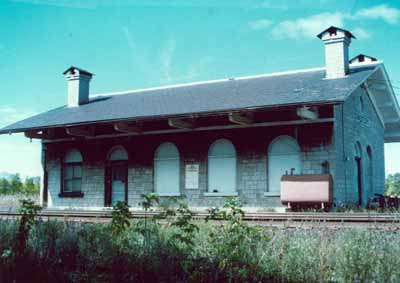Former Grand Trunk Railway (Canadian National Railways) Station
Heritage Railway Station of Canada
Ernestown, Ontario

Exterior photo
(© (A. M. de Fort-Menares, 1991.))
Address :
Ernestown, Ontario
Recognition Statute:
Heritage Railway Stations Protection Act (R.S.C., 1985, c. 52 (4th Supp.))
Designation Date:
1992-06-04
Dates:
-
1855 to 1856
(Construction)
Research Report Number:
RS-089
Description of Historic Place
The Former Grand Trunk Railway (now Canadian National Railways) Station at Ernestown is a one-storey, stone railway station, built in 1855-56. It is located in a rural setting, near the town of Odessa on the northern shore of Lake Ontario. The formal recognition is confined to the railway station building itself.
Heritage Value
Built by the Grand Trunk Railway (GTR) in the mid-19th century, the Ernestown railway station represents the first phase of construction of Canada’s first transcolonial and international railway. Its location along the Montréal to Toronto route reflects the sometimes arbitrary placement of GTR stations. The 19th-century community of Ernestown Station was created by the construction of the station and was completely rail-dependent.
The Ernestown railway station is one of nine surviving mid-19th-century GTR stations in Ontario, and retains the most early fabric and detailing. It is an example of the Type C station built by the GTR in smaller communities and rural townships. Its Italianate style and stone construction are characteristic of first-generation GTR stations.
The station retains its traditional relationship to the railway tracks.
Sources: Heritage Character Statement, Former Grand Trunk Railway Station (now Canadian National Railways), Ernestown, Ontario, October 1992; Anne M. de Fort-Menares, Railway Station Report 089, Former Grand Trunk Railway Station (now Canadian National Railways), Ernestown, Ontario.
Character-Defining Elements
Character-defining elements of the Former Grand Trunk Railway (now Canadian National Railways) Station at Ernestown include: its Italianate style, evident in: its snug profile; low-pitched roof; wide, overhanging eaves supported by elaborate wooden brackets; exposed rafter ends; three, surviving picturesque chimneys; arched bays along all elevations; and the use of rock-faced, ashlar limestone masonry; its small size, typical of Type C GTR stations, and consisting of five bays along each of the main elevations; wood elements on the exterior, including: narrow, boarded soffits following the line of the roof; end rafters; and triangular brackets; 14 rounded arched openings, 11 of which were shortened and filled in the late 19th century but whose original outlines are still legible ; surviving original fenestration, including tripartite lancet transoms over the sash windows; its fine stonework, evident in: the regular, coursed, limestone ashlar of the walls; the subtle quoins at corners and alternating surrounds at window and door openings; the corners of all openings, sawn or chiselled to a flat delicate surface; and the base plinth; surviving original interior finishes extant under newer work, including: wood floors; and tongue-and-groove wainscoting;